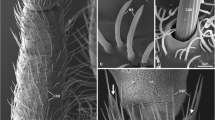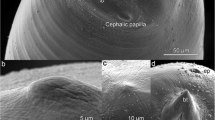Abstract
Cochliomyia macellaria (Diptera: Calliphoridae) is known as the secondary screwworm because it causes secondary or facultative myiasis when the larvae feed on necrotic tissues. This fly has a significant medical and veterinary importance since it has been reported to transport eggs of Dermatobia hominis (human botfly), which can cause significant economic losses to livestock. Since this screwworm has been collected colonizing both pig carcasses and human cadavers, it is considered one of the most important species for forensic entomology studies. Scanning electron microscopy (SEM) gives detailed information on the morphological characteristics which can help identify the immature forms of the flies. The aim of this study was to describe and analyze the morphological characteristics of the eggs, all the larval instars, and the puparia of Cochliomyia macellaria using SEM. The egg is ellipsoid and the dorsal surface is concave. The islands inside the median area had no anastomosis, but some perforations could be observed. From the second larval instar onwards, besides the intersegmental spines, other bands of spines were observed at the abdominal segments. Two spiracular openings were visible on the first and second larval instars, which were not expected. These characteristics are specific to Cochliomyia genus. The number and the general aspect of the spine tips in the cephalic region, the intersegmental bands on the abdomen, and the number of the spiracular openings could together help identify C. macellaria.





Similar content being viewed by others
References
Anziani OS, Flores SG, Moltedo H, Derozier C, Guglielmone AA, Zimmermann GA, Wanker O (2000) Persistent activity of doramectin and ivermectin in the prevention of cutaneous myiasis in cattle experimentally infested with Cochliomyia hominivorax. Vet Parasitol 87(2–3):243–247
Barbosa RR, Mello-Patiu CA, Mello RP, Queiroz MMC (2009) New records ofcalyptrate dipterans (Fanniidae, Muscidae and Sarcophagidae) associated withthe decomposition of domestic pigs in Brazil. Mem Inst Oswaldo Cruz 104:923–926.
Barreto M, Burbano ME, Barreto P (2002) Flies (Calliphoridae, Muscidae) and beetles (Silphidae) from human cadavers in Cali, Colombia. Mem Inst Oswaldo Cruz 97(1):137–138
Biavati GM, Santana FHAR, Pujol-Luz JR (2010) A checklist of Calliphoridae blowflies (Insecta, Diptera) associated with a pig carrion in central Brazil. J Forensic Sci 55(6):1603–1606
Catts EP, Goff ML (1992) Forensic entomology in criminal investigations. Annu Rev Entomol 37:253–272
d’Almeida JM, Lopes HS (1983) Sinantropia de dípteros caliptratos (Calliphoridae) no estado do Rio de Janeiro. Arq Univ Fed Rural do Rio de Janeiro 6(1):39–48
Erzinclioglu YZ (1989) The value of chorionic structure and size in the diagnosis of blowfly eggs. Med Vet Entomol 3:281–285
Florez E, Wolff M (2009) Descripción y Clave de los Estadios Inmaduros de las Principales Especies de Calliphoridae (Diptera) de Importancia Forense en Colombia. Neotropical Entomol 38(3):418–429
Grisi L, Massard CL, Moya-Borja GE, Pereira JB (2002) Impacto econômico das principais ectoparasitoses em bovinos no Brasil. A Hora Veterinária 125:8–10
Gruner SV, Slone DH, Capinera JL (2007) Forensically important Calliphoridae (Diptera) associated with pig carrion in rural north-central Florida. J Med Entomol 44(3):509–515
Guimarães JH, Amorim DS (2006) Diptera. In: Costa C, Ide S, Simonka CE (eds) Insetos imaturos: metamorfose e, identificaçãoth edn. Holos, São Paulo
Guimarães JH, Papavero N (1999) Miíasis in man and animals in Neotropical region. ed. Pleiade/FAPESP, São Paulo.
Hayat MA (1970) Principles and techniques of electron microscopy. In: Biological applications. Van Nostrand Reinhold Company, New York
Hebert PDN, Ratnasingham S, deWaard JR (2003) Barcoding animal life: cytochrome c oxidase subunit 1 divergences among closely related species. Proc R Soc Lond B 270:S96–S99
Hinton HE (1981) Biology of insect eggs. ed. Pergamon Press, Oxford.
Leite ACR, Guevara JDE (1993) Scanning electron microscopy of the larval instars of Cochliomyia hominivorax. Med Vet Entomol 7:263–270
Liu D, Greenberg B (1989) Immature stages of some flies of forensic importance. Ann Entomol Soc Am 82:80–93
Margaritis LH (1985) Structure and physiology of eggshell. In: Kerkut GA, Gilbert LI (eds) Comprehensive insect physiology, biochemistry and pharmacology. v.I. Embryogenesis and reproduction. Pergamon Press, Oxford, pp 151–230
Mc Alpine JF, Peterson BV, Shewell GE, Teskey JH, Vockeroth JR, Wood DN (1981) Manual of Neartic Diptera, Ottawa.
Mendonça PM, Santos-Mallet JR, Mello RP, Gomes L, Queiroz MMC (2008) Identification of fly eggs using scanning electron microscopy for forensic investigations. Micron 39:802–807
Mendonça PM, Santos-Mallet JR, Queiroz MMC (2010) Ultramorphological characteristics of immature stages of Chrysomya albiceps (Wiedemann 1819) (Diptera: Calliphoridae), a fly specie of forensic importance. Micr Res Tech 73:779–784
Mendonça PM, Santos-Mallet JR, Queiroz MMC (2012a) Ultrastructure of larvae and puparia of the blowfly Chrysomya megacephala (Diptera: Calliphoridae). Micr Res Tech 75:935–939
Mendonça PM, Santos-Mallet JR, Queiroz MMC (2012b) Ultrastructure of immature stages of the blowfly Chrysomya putoria (Wiedemann, 1818) (Diptera: Calliphoridae). Micr Res Tech 75:206–211
Mendonça PM, Barbosa RR, Cortinhas LB, Santos-Mallet JR, Queiroz MMC (2013) Ultrastructure of immature stages of Peckia (Euboetcheria) collusor (Diptera: Sarcophagidae). Acta Trop 128:522–527
Nelson LA, Wallman JF, Dowton M (2007) Using COI barcodes to identify forensically and medically important blowflies. Med Vet Entomol 21:44–52
Nelson LA, Lambkin CL, Batterham P, Wallman JF, Dowton M, Whiting MF, Yeates DK, Cameron SL (2012) Beyond barcoding: a mitochondrial genomics approach to molecular phylogenetics and diagnostics of blowflies (Diptera: Calliphoridae). Gene 511:131–142
Oliva A (2001) Insects of forensic significance in Argentina. Forensic Sci Int 120(1–2):145–154
Oliveira TC, Vasconcelos SD (2010) Insects (diptera) associated with cadavers at the institute of legal medicine in Pernambuco, Brazil: implications for forensic entomology. Forensic Sci Int 198(1–3):97–102
Ortloff A, Peña P, Riquelme M (2012) Preliminary study of the succession pattern of necrobiont insects, colonising species and larvae on pig carcasses in Temuco (Chile) for forensic applications. Forensic Sci Int 222(1–3):e36–e41
Owings CG, Spiegelman C, Tarone AM, Tomberlin JK (2014) Developmental variation among Cochliomyia macellaria Fabricius (Diptera: Calliphoridae) populations from three ecoregions of Texas, USA. Int J Legal Med. doi:10.1007/s00414-014-1014-0
Peterson RD, Newman Junior SM (1991) Chorionic structure of the egg of the screwworm Cochliomyia hominivorax (Diptera: Calliphoridae). J Med Entomol 28:152–160
Queiroz MMC, Milward-de-Azevedo EMV (1991) Técnicas de criação e alguns aspectos da biologia de Chrysomya albiceps (Wiedemann) (Diptera, Calliphoridae), em condições de laboratório. Rev Bras Zool 8:75–84
Queiroz MMC, Mello RP, Lima MM (1997) Morphological aspects of the larval instars of Chrysomya albiceps (Diptera: Calliphoridae) reared in the laboratory. Mem Inst Oswaldo Cruz 92:187–196
Queiroz MMC, Norberg NA, Maure EAP, Toledo RF, Gazêta GS, Dutra AEA, Rodrigues-Guimarães R (1999) Veiculação de bactérias patogênicas por moscas sinantrópicas coletadas em restaurantes, hospitais e feiras da Baixada Fluminense, Rio de Janeiro, Brasil. [Apresentação no XIV Congresso Latinoamericano de Parasitologia; Acapulco, Guerrero; México].
Skoda SR, Figarola JL, Pornkulwat S, Foster JE (2013) Inter- and intraspecific identification of the screwworm, Cochliomyia hominivorax, using random amplified polymorphic DNA-polymerase chain reaction. J Insect Sci 13:76
Sukontason K, Sukontason KL, Ngern-Klun R, Sripakdee D, Piangjai S (2004a) Differentiation of the third instar of forensically important fly species in Thailand. Ann Entomol Soc Am 97(6):1069–1075
Sukontason K, Sukontason KL, Boonchu N, Chaiwong T, Piangjai S (2004b) Ultrastructure of eggshell of Chrysomya nigripes Aubertin (Diptera: Calliphoridae). Parasitol Res 93:151–154
Szpila K, Pape T (2008) Morphology of the first instar of the house fly Musca domestica (Diptera: Muscidae). J Med Entomol 45(4):594–599
Szpila K, Hall MJR, Wardhana AH, Pape T (2014) Morphology of the first instar larva of obligatory traumatic myiasis agents (Diptera: Calliphoridae, Sarcophagidae). Parasitol Res. doi:10.1007/s00436-014-3808-x
Velásquez Y (2008) A checklist of arthropods associated with rat carrion in a montane locality of northern Venezuela. Forensic Sci Int 174(1):68–70
Zumpt F (1965) Myiasis in man and animals in the old world. ed. Butterworths. London.
Acknowledgments
We would like to thank the Platform Electron Microscopy Rudolf Barth of Instituto Oswaldo Cruz (FIOCRUZ) for the use of the scanning electron microscope. This work was supported by grants from Instituto Oswaldo Cruz (IOC/FIOCRUZ), Conselho Nacional de Desenvolvimento Científico e Tecnológico (CNPq), Fundação Carlos Chagas Filho de Amparo à Pesquisa do Estado do Rio de Janeiro (FAPERJ), and Coordenação de Aperfeiçoamento de Pessoal de Nível Superior (CAPES).
Author information
Authors and Affiliations
Corresponding author
Rights and permissions
About this article
Cite this article
Mendonça, P.M., Barbosa, R.R., Cortinhas, L.B. et al. Ultrastructure of immature stages of Cochliomyia macellaria (Diptera: Calliphoridae), a fly of medical and veterinary importance. Parasitol Res 113, 3675–3683 (2014). https://doi.org/10.1007/s00436-014-4032-4
Received:
Accepted:
Published:
Issue Date:
DOI: https://doi.org/10.1007/s00436-014-4032-4




